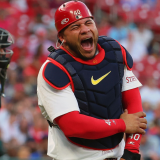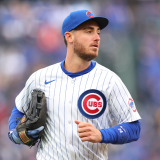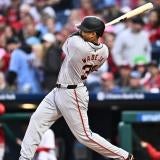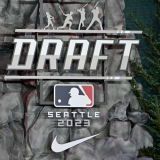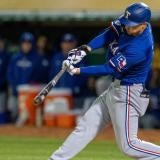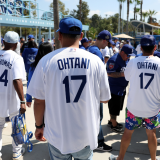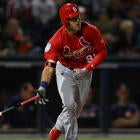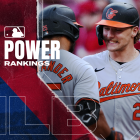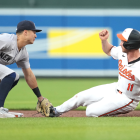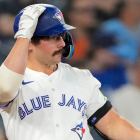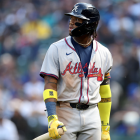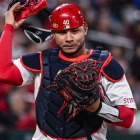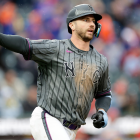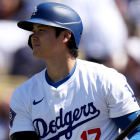With the regular season concluding, we've decided to take a look at each team's future -- not by using a crystal ball or other psychic abilities, but by evaluating their farm systems. Below you'll find our ranking of the top five prospects in the organization -- sorted by perceived future potential -- as well as five other players who fit various categories. Those categories are:
2020 contributor: A player who is likely to play a role for the big-league team next season.
Analyst's pick: A player who is a strong statistical performer and/or whose underlying measures are better than the scouting reports suggest.
Riser: A player on the way up.
Faller: A player on the way down.
One to watch: An interesting player to keep in mind (for whatever reason).
These rankings were compiled after talking with various industry sources about the systems (and players) in question. It should be acknowledged that this process is more art than science, and that there are limits to ordinal rankings. Still, it's an intuitive system, and our hope is that the write-ups will answer any questions by providing additional context and analysis of each player -- such as their pluses and minuses; the risk factors involved; and their estimated arrival date.
One last word on eligibility: we're following MLB's rookie guidelines by disqualifying any player with more than 130 big-league at-bats or 50 innings pitched.
The Cardinals aren't churning out studs like they used to, but they do have a few prospects worth keeping an eye on.
1. Dylan Carlson, OF
Dylan Carlson, the 33rd pick in the 2016 draft, positioned himself for a 2020 callup thanks to a strong season that saw him hit .281/.364/.518 with 21 homers and 18 steals in Double-A.
Carlson is a well-rounded switch hitter who was better as a lefty in 2019. (He was better as a righty in 2018, so it doesn't appear to be part of a bigger trend.) He cut into his ground ball rate this season, presumably in pursuit of better leveraging his raw strength. It worked, as he posted the highest ISO of his professional career despite playing in the upper-minors.
As it stands, Carlson projects to hit for average and power while also drawing a lot of walks. There's perhaps a chance he sacrifices more of his hit tool for additional power (or vice versa), but that's to be seen. Add up the entire package, and it's easy to envision him being a productive everyday member of a good lineup.
Defensively, Carlson has an above-average arm and should be fine in right. He's already listed at 6-foot-3, 205 pounds so there's a chance he someday outgrows the position. For now, he's the Cardinals prospect likeliest to start important games for them in 2020.
2. Nolan Gorman, 3B
Teenage third baseman Nolan Gorman reached High-A in his first full professional season, and his performance there highlighted some of the concerns about his game.
Gorman has well-above-average power and the chance to stick at third base for at least the start of his big-league career. The catch is that he's likely to strike out -- a lot. To wit, he fanned in nearly a third of his plate appearances following his promotion to High-A. He also saw his walk rate and ISO dip (though he remained an above-average hitter overall).
You probably don't need to be told why Gorman's profile is risky, so let's just be clear about something: He's still a high-quality prospect due to his age, his loud tool, and his makeup.
There's absolutely downside here, too -- either that Gorman doesn't make enough contact to maximize his pop, or that his defense at the hot corner forces him elsewhere -- but there's middle-of-the-order upside that shouldn't be discarded just because of his variability.
3. Andrew Knizner, C
With Carson Kelly traded to the Arizona Diamondbacks as part of the Paul Goldschmidt deal, Andrew Knizner became the top young catcher in the system.
Knizner is a bat-first backstop who originally converted to behind the plate during his collegiate days. He's a below-average receiver but he does have more than enough arm for the position and should remain back there so long as he continues to make progress in the more nuanced areas.
At the dish, Knizner has shown an appreciable feel for contact. Prior to this season, he'd hit .300 or better at almost every minor-league stop, and has yet to strike out more than 14 percent of the time during a full season. The upside here is a catcher who pitches in across the board offensively and who doesn't give away most or all of that value on defense.
Because Yadier Molina is under contract for another season, it's probably fair to expect Knizner to spend a fair amount of 2020 in the minors.
4. Zack Thompson, LHP
Left-hander Zack Thompson became the highest pitcher ever drafted from the University of Kentucky when the Cardinals popped him 19th overall. He was also the first Wildcats pitcher selected in the first round since Alex Meyer back in 2011.
The main concern with Thompson is health. He missed a good chunk of his sophomore season due to elbow trouble, and it's not like anyone needs an additional reason to doubt whether or not a pitcher will remain hearty and hale in the first place.
If Thompson can stay on the mound, he could move quickly through the system thanks to a broad arsenal (led by a good fastball-breaking ball combination) and feel for the craft.
5. Elehuris Montero, 3B
Elehuris Montero boosted his stock in 2018 with a strong age-19 season that saw him homer 15 times while hitting .322/.381/.529 in A-ball. He did not have as much success this season as a 20-year-old in High-A.
Instead Montero's aggressive approach seemed to get the better of him. He hit just .188/.235/.317 and struck out in more than 31 percent of his trips to the plate. Ouch.
Montero is a well-built feller with above-average raw power. Despite a strong arm, he might have to move off third base at some point down the road. As such, the pressure is on his stick -- and on improving his plan at the plate. It's worth sticking with him for another season to see if he can make the necessary adjustments.
2020 contributor: Junior Fernandez, RHP
Junior Fernandez threw 11 innings in the majors this season, showing legitimate bat-missing potential thanks to a mid-to-upper 90s fastball, a good changeup, and a slider that always lagged behind his other offerings. Fernandez still struggles with his command, but figures to spend more time in the majors next season -- and could find himself with a high-leverage role if he can smooth out his wrinkles a little more.
Analyst's pick: Kodi Whitley, RHP
Kodi Whitley posted some eye-catching statistics across two levels in 2019, including a 23-inning stint in Triple-A that saw him fan 10-plus and walk just 1.52 batters per nine. Whitley is just a right-handed reliever, but he comes at batters from an over-the-top release and he improved both his velocity and his spin this season. He could pitch in the majors as soon as spring 2020, and might well find himself pitching in the seventh inning down the road behind the strength of his fastball-breaking ball combination.
Riser: Randy Arozarena, OF
All Randy Arozarena has done is hit in the minors -- he hit .344/.431/.571 with 15 homers and 17 steals (on 29 attempts) between Double- and Triple-A this season -- to the extent that it earned him a big-league promotion and spot on the postseason roster. Arozarena has a well-rounded skill set and ranked in the 96th percentile in sprint speed during his cameo, suggesting he should latch on as at least a reserve outfielder as soon as the 2020 season.
Faller: Adolis Garcia, OF
Cuban outfielder Adolis Garcia has the physical attributes -- the strength, the speed -- to be a quality player. Unfortunately, his approach is going to keep him on the minor-league side of things. Garcia struck out more than 30 percent of the time in Triple-A while walking in just over four percent of his plate appearances. That's not going to work -- heck, it isn't working: he was a well-below-average hitter for Triple-A despite homering 32 times.
One to watch: Ramon Urias, INF
Ramon Urias gets the nod here because of his big-league bloodlines (he's the older brother of Padres infielder Luis) and because of his backstory -- the Cardinals signed him out of Mexico last spring. Urias is on the smaller side, predictably, and he might boast multiple below-average tools at this point -- in his power and running. Nonetheless, he can hit a bit and could step into a bench role as soon as tomorrow if needed.







